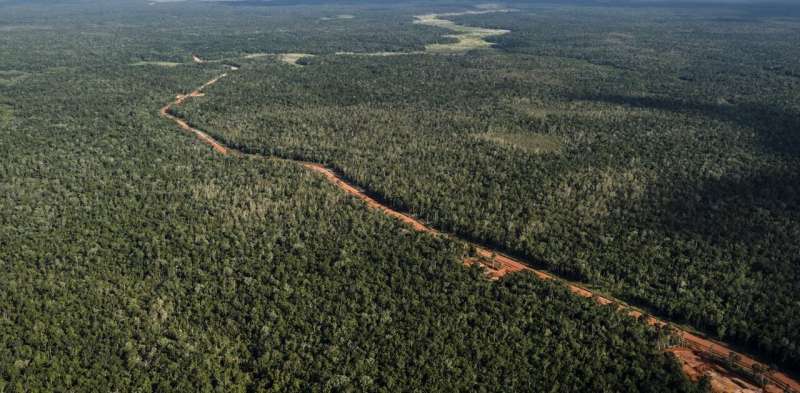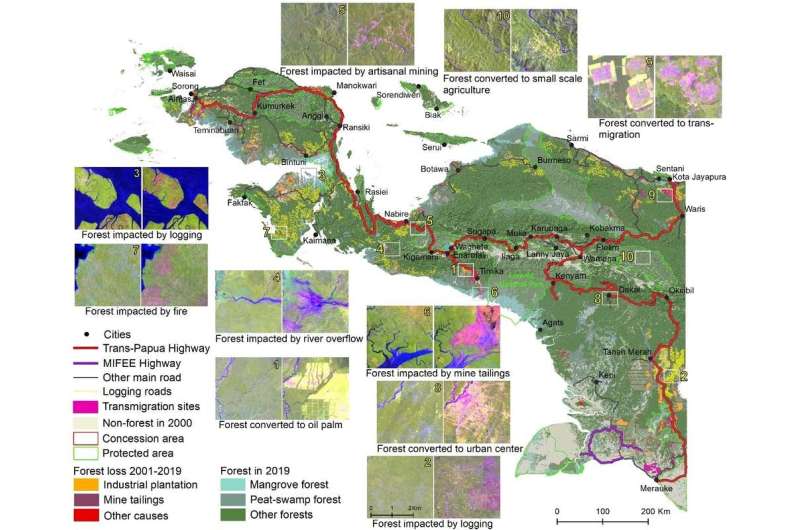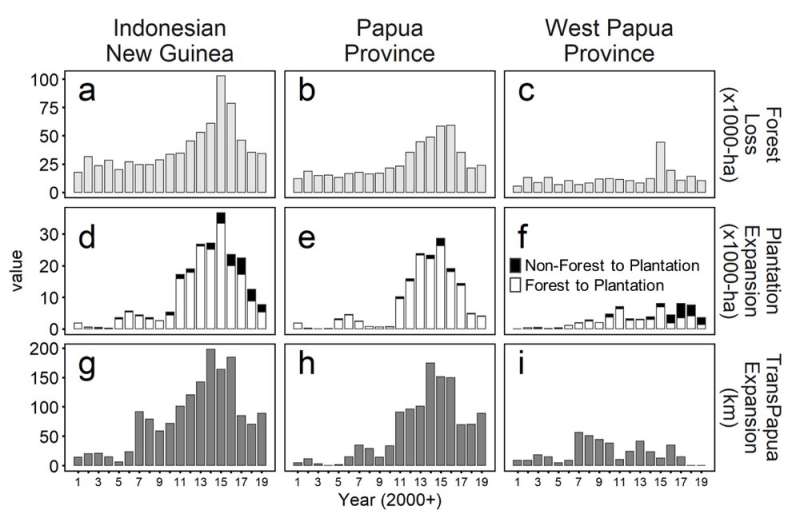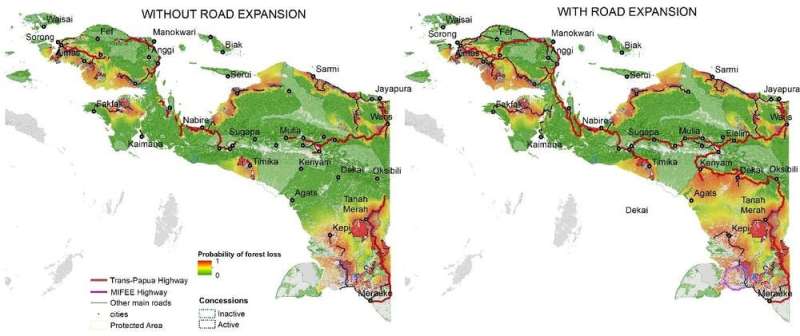Aerial view of the new highway cutting through lowland forest in Papua Province. Credit: Ulet Ifansasti/Greenpeace
Indonesia's Papuan land is the western half of New Guinea—the world's second-largest island—which hosts extensive old-growth forests, including mangroves and peat swamps. It has more plant species than any other tropical island.
In our new study published recently in Biological Conservation, we used satellite imagery to develop for the first time a model to predict future deforestation in Papua. It's based on analysis of forest loss, plantation expansion and road development in the area from 2001 to 2019.
Papua lost only 2% (748,640 hectares) of forest between 2001 and 2019, much less than other Indonesian islands Sumatra and Kalimantan, which lost 25% and 14% respectively. However, our model predicts 4.5 million hectares (Mha) – around 13% of the total 34.29Mha of forest—could disappear by 2036. That's a result of the development of thousands of kilometers of highway in a project known as "Trans Papua."
The highway project and its impact
Our study found 83% (34.29Mha) of Papuan land remained forest in 2019. This area represents 42% of Indonesia's forests and is the Asia Pacific region's largest area of intact old-growth forest.
But it will soon change with the Trans Papua development.
We mapped 3,887km of Trans-Papua Highway (officially, Trans-Papua is 4,330km long.)
Map of land use and land cover change 2000 to 2019. The insets show two image pairs taken before and after forest cover change at ten specific locations. All insets have the same scale. This map can be viewed interactively at: https://nusantara-atlas.org. Credit: Nusantara-atlas.org
This included a 202km road section through the Lorentz National Park, a World Heritage site. In 2019, the opening of Trans-Papua Highway was nearly complete (red lines on the map above), though 51km remained unopened.
Many are concerned that the highway, and other roads, are being built to benefit powerful commercial interests and not Indigenous people and will accelerate forest conversion as seen in Sumatra and Kalimantan.
Our study has confirmed this fear, as the graphs below show.
While overall forest losses remain limited, our model shows significant deforestation occurred near existing roads, and indicates how new roads are likely to encourage more extensive deforestation in lowland areas, as the maps below show. A similar pattern happened after 2011 when expansion of plantations and roads caused a spike in deforestation in 2015 and 2016, particularly in Papua Province.
The construction of new roads increased the area of forest at risk of deforestation (red areas on maps) by 30% compared to the hypothetical scenario of halting such developments.
Lowland forests near the cities of Dekai and Kenyam—located in central Papua Province—experienced the highest augmented threat.
Land use changes in Tanah Papua (Indonesian New Guinea) and its two provinces, Papua and West Papua (2001-20219). The graphs show annual loss of forest area (a, b, c), the concomitant annual expansion of industrial plantations of oil palm and pulpwood (97% oil palm; 3% Acacia for pulp and paper) (d, e, f) and the expansion of the Trans-Papua Highway (g, h, i). The white bars in d, e, f represent the area of forest cleared and converted to industrial plantations in the same year. Credit: David Gaveau
Roads generally attract interest from plantation companies and from other extractive industries, such as mining, because they ease access and transportation.
Companies invest in new plantations and new mining sites, processing plants, secondary roads and other infrastructure associated with developing these industries. These investments attract workers and their families from elsewhere, requiring more infrastructure and thus more land and more deforestation.
The clearance comprises 70% (3.2Mha) of land along the highway through new infrastructure, secondary roads and population growth, and the remaining 30% (1.3Mha) converted to industrial plantations, pulp and paper production, and mining in concessions.
These causes and trends in Papua follow similar deforestation rates to those we have observed previously in Kalimantan on the island of Borneo.
In the Borneo observations, we had already examined forest loss, road development and plantation expansion using satellite imagery over four decades.
It would be futile to ask the Indonesian government to halt this project because the Trans-Papua highway is nearly complete, and many local people aspire to reduced isolation. But that doesn't mean we should be resigned to extensive forest clearance.
Map of Tanah Papua showing a hypothetical deforestation-risk map without road expansion, i.e. as roads were in 2000 (left panel), and with the observed expansion of roads between 2001 and 2019 (right panel). Trans-Papua and Merauke Integrated Food and Energy Estate Highways are shown by red and purple lines and other main roads are black. Areas of forest at high risk of deforestation are in red while low-risk areas are green. Credit: David Gaveau
So, what can be done?
In Papua, the roles of local communities and Indigenous peoples are influential in guarding and protecting nature. And Indonesia's law has recognized this.
The 2012 decision of the National Constitutional Court (35/PUU-X/2012) recognized the rights and authority of local communities over their ancestral territories as consistent with Indonesia's constitution.
Respecting the rights of locals, the governors of Papua and West Papua Provinces signed the Manokwari Declaration in 2018.
The declaration requires local governments to conserve at least 70% of the region, and to engage in consultative and information-based conservation planning and management that ensures "environmentally appropriate" infrastructure developments while also protecting the rights and roles of Indigenous peoples.
Under this declaration, and a national moratorium ordering a review of existing permits, the provincial government of West Papua recently revoked permits for 12 oil palm concessions. More such interventions are likely.
Four decades of forest loss, industrial plantation expansion (oil palm and pulpwood in black) and road expansion in Borneo. This map can be viewed interactively at: https://nusantara-atlas.org. Credit: https://nusantara-atlas.org
The move represents an important step towards recognizing the rights of Indigenous peoples and preserving natural habitats in West Papua.
Therefore, what we need is to build conservation and development opportunities around what Indigenous Papuans themselves find important and desirable.
Effective, consensual and frequent engagement between local people, or their elected representatives, and all layers of government will be key to ensure alignment of local, regional and national development planning to avoid the less-desirable consequences of development seen in Sumatra and Kalimantan and preserve the rich biological and cultural heritage of this remarkable region.
Journal information: Biological Conservation
Provided by The Conversation
This article is republished from The Conversation under a Creative Commons license. Read the original article.![]()
























